Besides Midwest barbecue and the agricultural industry, Missouri is known for its gorgeous state parks and assorted ecoregions: upland prairies, lowland plains, and part of the Ozark plateau. And the state has more than 350 lakes, rivers, streams, and tributaries, all perfect for supporting wildlife, especially birds. Discover nine blue birds in Missouri and find out where they live, what they eat, how they sound, and what they look like.
Blue Grosbeak
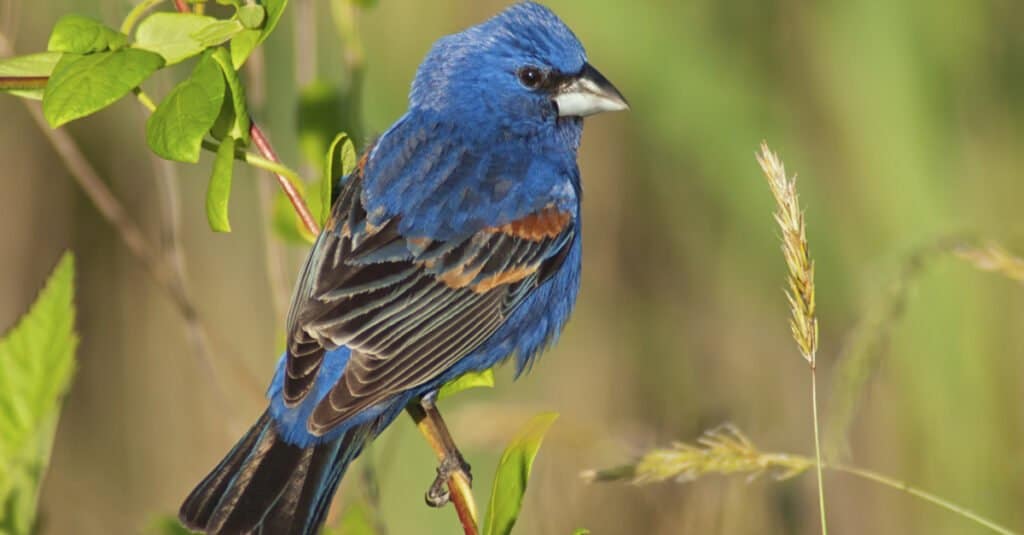
Blue grosbeaks breed in Southern Missouri in tangled vines and shrubs near streams and forest edges.
©Michael G. Mill/Shutterstock.com
Migration and Habitat: The blue grosbeak breeds in the southern half of Missouri and throughout the rest of the Southern US. The winter in Mexico, the West Indies, and Central America. It spends the breeding season in tangled vines and shrubs, typically near stream and forest edges.
Features and Coloring: They are stocky birds with large heads and triangular bills. Their plumage is a vibrant blue with chestnut wingbars and silver beaks.
Food: Grasshoppers and crickets are their favorite food but they also consume other insects, seeds, and grains.
Vocalizations: They make unique sweet, metallic warbles.
Nests: Their nest is an open twig and weed cup that they place in low shrubs, vines, and trees.
Cerulean Warbler
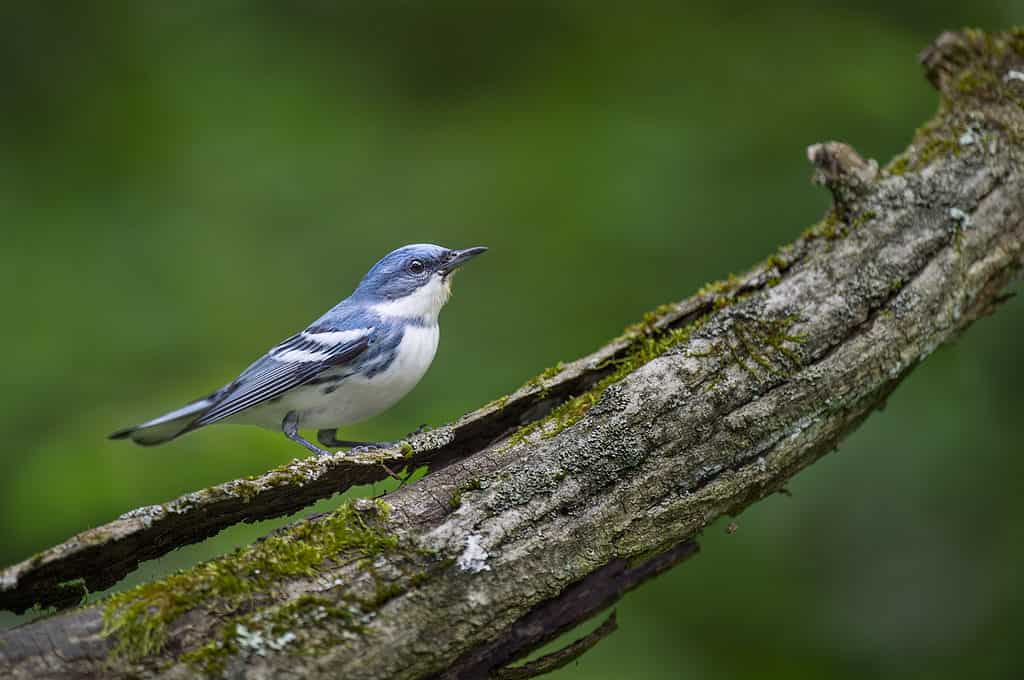
The cerulean warbler is an uncommon breeder in Missouri but you may spot them in mature deciduous forests.
©iStock.com/ps50ace
Migration and Habitat: Cerulean warblers are an uncommon breeder in Missouri. They most commonly breed in the Northeast, migrate through the Southeast, Mexico, and Central America, and winter in South America. You may spot them in significant tracts of mature deciduous forests.
Features and Coloring: The cerulean warbler holds itself in a horizontal position. Its body is relatively compact and small, featuring sky-blue plumage with a white underside and black barring on the wings.
Food: These insectivores enjoy beetles, caterpillars, and flies. They occasionally eat plant material.
Vocalizations: You’ll hear their high-pitched buzzy notes.
Nests: Their nests are shallow cups made of bark strips and grass and placed on horizontal tree branches.
Northern Parula
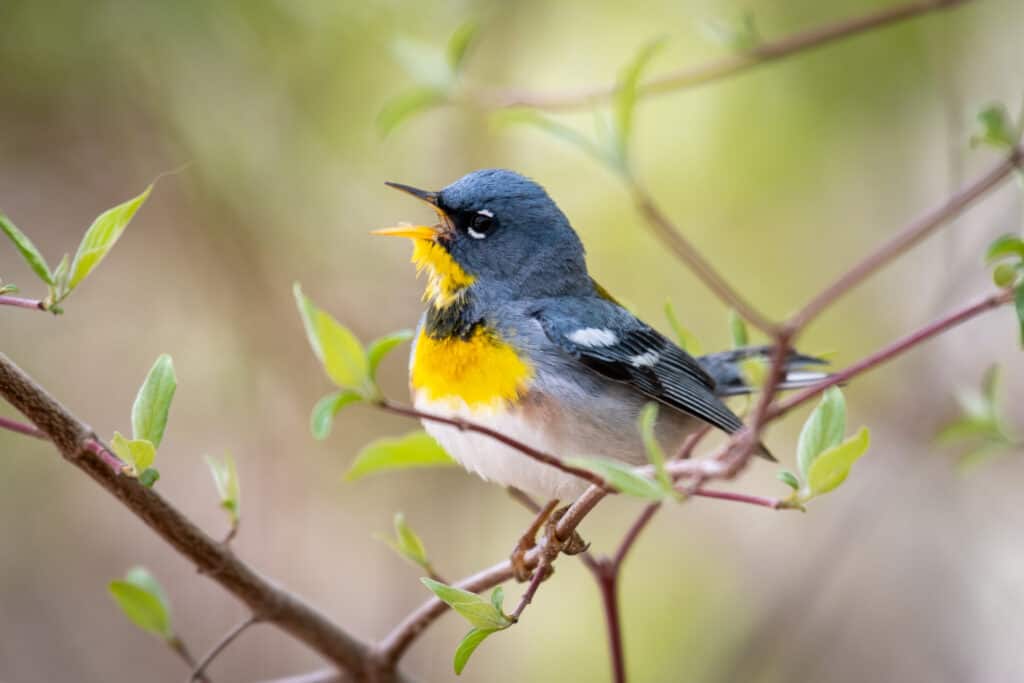
The northern parula is a small warbler that lives in forest canopies during summer and tropical plantations in the winter.
©Nattapong Assalee/Shutterstock.com
Migration and Habitat: Northern parulas breed in Southeastern Missouri and throughout much of the Southeast. They migrate through Texas and Florida before reaching their wintering grounds in Mexico and the West Indies. They are most likely to be found in mature forests near streams and swamps.
Features and Coloring: They are small with short tails and skinny beaks. Their plumage is grayish-blue above and white below, with bright yellow breasts and throats.
Food: During summer, they primarily eat spiders and insects, especially caterpillars. During winter, however, they may consume seeds, berries, and nectar.
Vocalizations: These birds make ascending buzzy notes.
Nests: They construct small hanging pouches of lichen and twigs inside tree lichen or Spanish moss.
White-Breasted Nuthatch
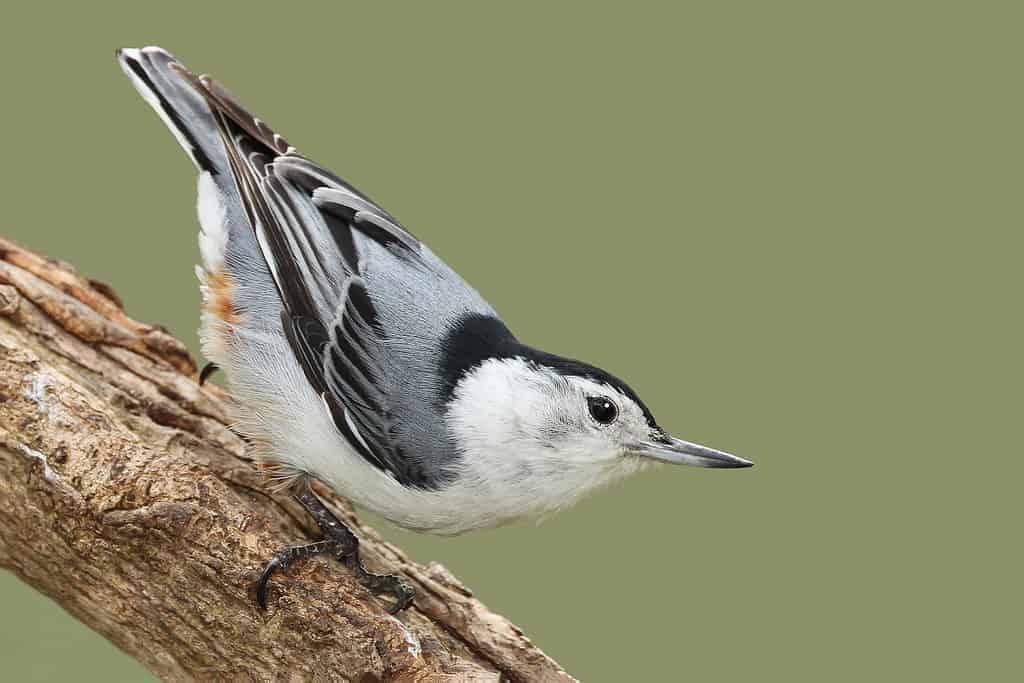
The white-breasted nuthatch is a permanent resident in Missouri, where it inhabits mature deciduous forests.
©Brian Lasenby/Shutterstock.com
Migration and Habitat: White-breasted nuthatches live year-round in Missouri and most of the United States, except the extreme southern regions. However, they may move in irruptive patterns during winter. They live in mature deciduous woods.
Features and Coloring: These birds have short tails and appear to have no necks. Their backs, wings, and tails are bluish-gray with heavy dark streaking. Their undersides are white, and they have black caps.
Food: They mainly eat insects but will also consume seeds and nuts. This species is popular at bird feeders and eats a variety of food, like suet, peanut butter, and sunflower seeds.
Vocalizations: Low whistling and nasal notes are their calls.
Nests: This bird nests in large cavities, which hold a simple bark fiber cup.
Red-Breasted Nuthatch
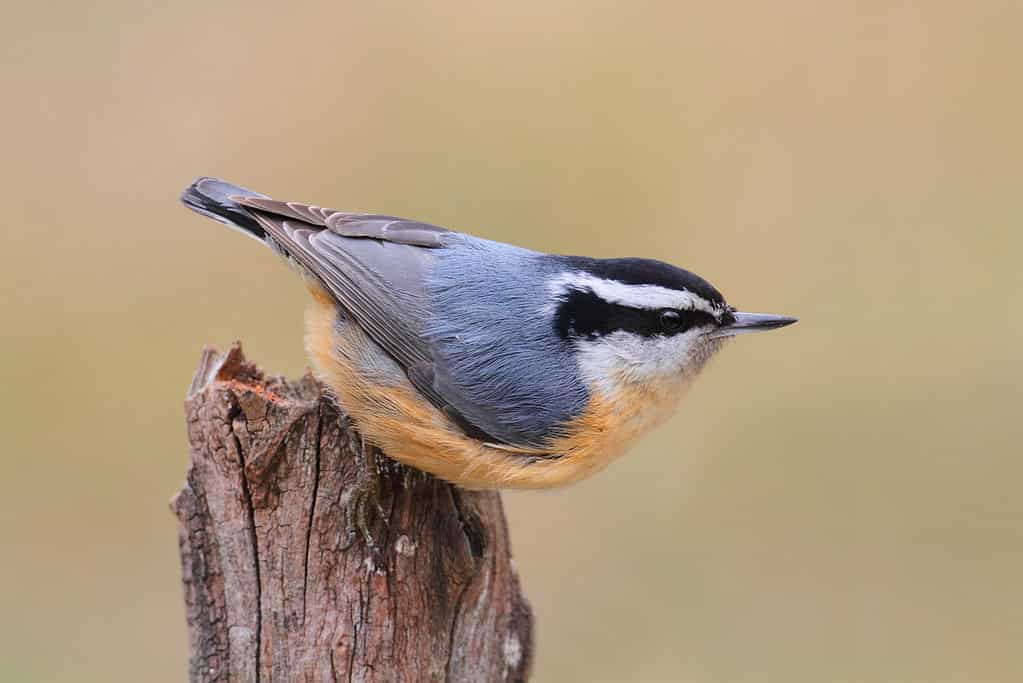
Red-breasted nuthatches winter across Missouri and live in deciduous woods. They eat seeds and feeder food.
©iStock.com/SteveByland
Migration and Habitat: The red-breasted nuthatch spends its winters across Missouri and most of the United States. Populations in Canada and many regions of the West are permanent residents. Those further east typically inhabit deciduous woods.
Features and Coloring: Similar to the white-breasted species, they have almost no neck and their tails are very short. Their backs are bluish-gray and their undersides are rusty red. Their heads have black and white stripes.
Food: During winter, they eat seeds and feeder food, such as peanuts, suet, and sunflower seeds. In summer, they prefer insects.
Vocalizations: Listen for their high-pitched nasal calls.
Nests: Their nest is made of soft grass and moss and placed in a cavity.
Eastern Bluebird
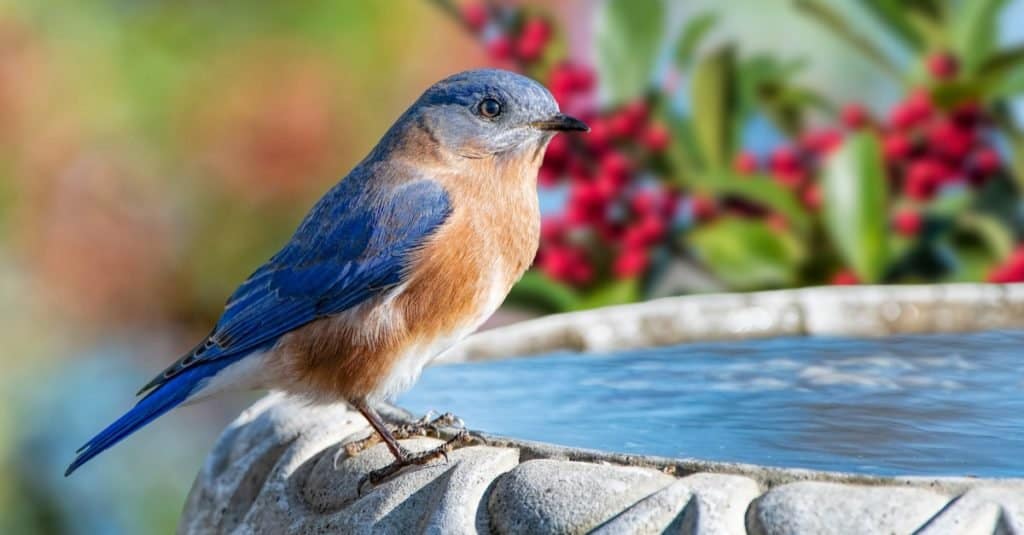
The eastern bluebird breeds in Northern Missouri and lives in the southern half permanently. You can find them in open areas with few trees.
©Bonnie Taylor Barry/Shutterstock.com
Migration and Habitat: Populations in Southern Missouri live there year-round, but those in the north only stay during the summer for the breeding season. This species typically breeds in the Northeast and lives year-round in the Southeast. Look for them in open areas around trees with little ground cover.
Features and Coloring: Their small, plump bodies feature round heads with large eyes. They are bright blue above and white below with rusty red breasts.
Food: They have a wide-ranging diet but eat mainly ground-dwelling insects in the summer and fruit in the winter.
Vocalizations: They make soft, musical warbles.
Nests: They place a loose weed and twig cup in a tree cavity or old woodpecker hole.
Blue Jay
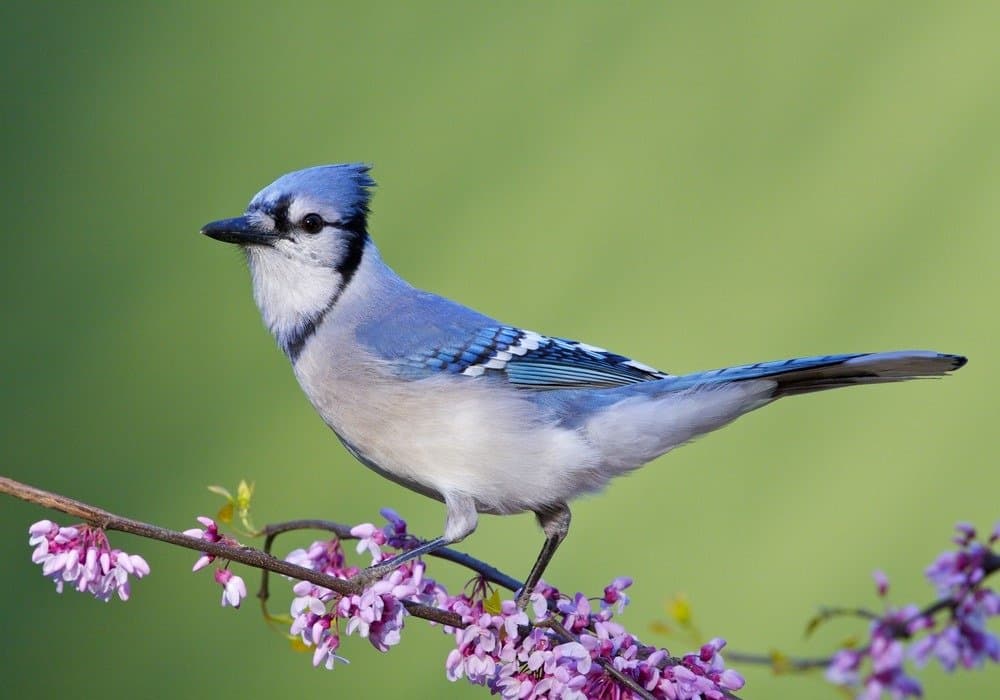
Blue jays live year-round in Missouri, inhabiting oak forest edges, cities, and towns.
©Tom Reichner/Shutterstock.com
Migration and Habitat: The blue jay is prolific across the Eastern United States and lives year-round in Missouri. They prefer oak forest edges, but they also inhabit cities and towns, especially near bird feeders.
Features and Coloring: They are smaller than crows but still large for a songbird. They also feature prominent crests and long, broad tails. Their upperparts are a mix of sky blue and deep blue with black and white patterns, and their undersides are light gray.
Food: Another bird with a varied diet, the blue jay eats insects, seeds, nuts, vertebrates, eggs, and birds.
Vocalizations: They have raucous cries and screams!
Nests: Their nests are bulky twigs and grass cups in the vertical crotch of a trunk.
Blue-Headed Vireo
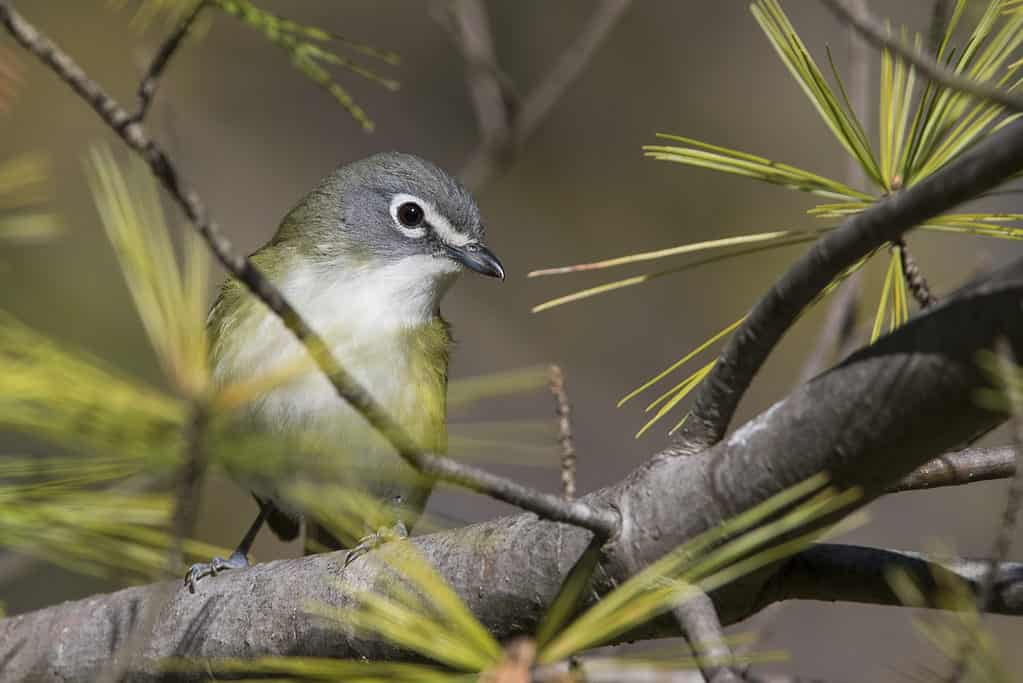
Blue-headed vireos are migrants through Missouri, stopping in suburban parks and yards.
©iStock.com/mirceax
Migration and Habitat: The blue-headed vireo is a migrant through Missouri. This species breeds in the Northeast and Canada, migrates through the East, and winters along the Southeast coast and Mexico. You will most likely see them in suburban parks and yards during migration.
Features and Coloring: This subtle blue bird has a bluish-gray head and a moss-green body with white underparts. They are small and stocky with a heavy, hooked bill.
Food: They eat many types of fruits and insects, including beetles, moths, butterflies, bees, ants, grasshoppers, and crickets.
Vocalizations: Their songs are soft, sweet, and slurred.
Nests: Their nest is made of grass, bark, and weeds and placed in a horizontal tree branch fork.
Blue-Gray Gnatcatcher
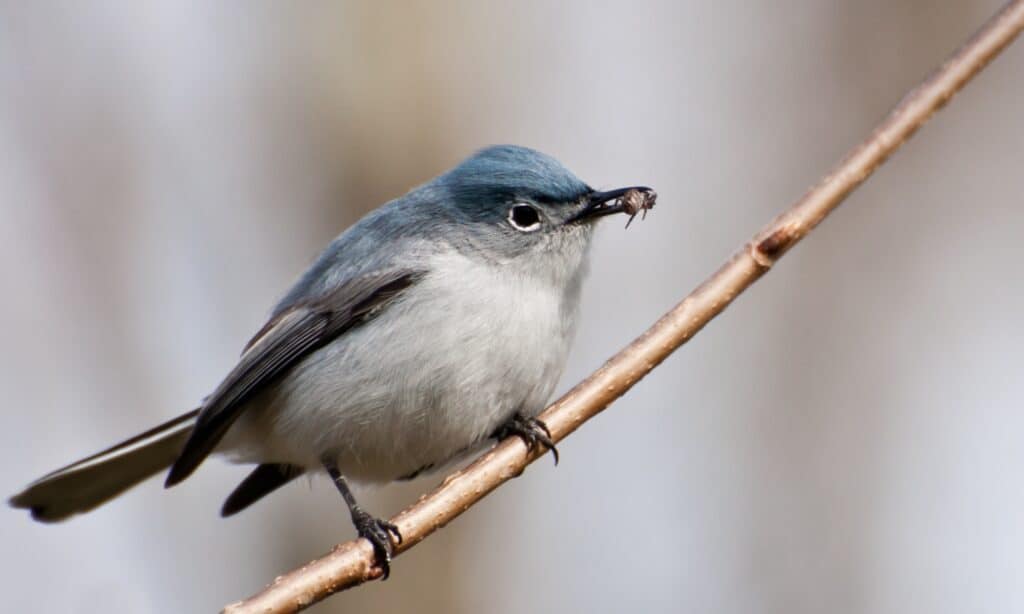
This species consumes many small insects and spiders.
©iStock.com/JasonOndreicka
Migration and Habitat: Blue-gray gnatcatchers breed across Missouri, including most of the southern half of the United States. Populations along the southeastern coast and California are permanent residents. They will nest in many woodland habitats but prefer moist areas near river and stream edges.
Features and Coloring: As their name suggests, their plumage is bluish-gray above and light gray to white below. They are tiny birds with long legs and long tails.
Food: This species consumes many small insects and spiders. They will also take advantage of abundant prey in a particular region, such as moths in the Northeast.
Vocalizations: They emit thin, whining warbles.
Nests: The nest is an open grass and weed cup placed in a deciduous tree.
The photo featured at the top of this post is © iStock.com/SteveByland
Thank you for reading! Have some feedback for us? Contact the AZ Animals editorial team.






